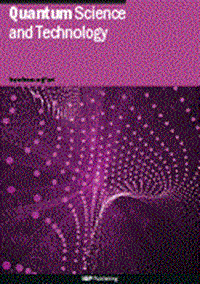混合态量子生成分类
IF 5
2区 物理与天体物理
Q1 PHYSICS, MULTIDISCIPLINARY
引用次数: 0
摘要
分类可以使用判别式或生成式学习方法进行。判别学习包括构造给定输入的输出的条件概率,而生成学习包括构造输入和输出的联合概率密度。尽管大多数经典方法和量子方法都是判别式的,但生成式学习方法也有一些优点。例如,它可以应用于无监督学习、统计推断、不确定性估计和合成数据生成。在本文中,我们提出了一种量子生成多类分类策略,称为量子生成分类(QGC)。该模型采用变分量子算法,通过混合量子态估计数据集特征和标签的联合概率密度函数。我们还介绍了一种称为量子增强傅立叶特征的量子映射,它利用量子叠加在量子硬件中使用少量量子位准备高维数据样本。我们证明了QGC算法可以被看作是一个高斯混合,它再现了训练数据的核希尔伯特空间。此外,我们开发了一个混合量子-经典神经网络,表明它可以在高维数据集上执行生成分类。该方法在各种低维和高维数据集上进行了测试,包括10类MNIST和Fashion-MNIST数据集,表明生成分类策略与其他先前的量子模型相比具有竞争力。本文章由计算机程序翻译,如有差异,请以英文原文为准。
Quantum generative classification with mixed states
Classification can be performed using either a discriminative or a generative learning approach. Discriminative learning consists of constructing the conditional probability of the outputs given the inputs, while generative learning consists of constructing the joint probability density of the inputs and outputs. Although most classical and quantum methods are discriminative, there are some advantages of the generative learning approach. For instance, it can be applied to unsupervised learning, statistical inference, uncertainty estimation, and synthetic data generation. In this article, we present a quantum generative multiclass classification strategy, called quantum generative classification (QGC). This model uses a variational quantum algorithm to estimate the joint probability density function of features and labels of a data set by means of a mixed quantum state. We also introduce a quantum map called quantum-enhanced Fourier features, which leverages quantum superposition to prepare high-dimensional data samples in quantum hardware using a small number of qubits. We show that the QGC algorithm can be viewed as a Gaussian mixture that reproduces a kernel Hilbert space of the training data. In addition, we developed a hybrid quantum–classical neural network that shows that it is possible to perform generative classification on high-dimensional data sets. The method was tested on various low- and high-dimensional data sets including the 10-class MNIST and Fashion-MNIST data sets, illustrating that the generative classification strategy is competitive against other previous quantum models.
求助全文
通过发布文献求助,成功后即可免费获取论文全文。
去求助
来源期刊

Quantum Science and Technology
Materials Science-Materials Science (miscellaneous)
CiteScore
11.20
自引率
3.00%
发文量
133
期刊介绍:
Driven by advances in technology and experimental capability, the last decade has seen the emergence of quantum technology: a new praxis for controlling the quantum world. It is now possible to engineer complex, multi-component systems that merge the once distinct fields of quantum optics and condensed matter physics.
Quantum Science and Technology is a new multidisciplinary, electronic-only journal, devoted to publishing research of the highest quality and impact covering theoretical and experimental advances in the fundamental science and application of all quantum-enabled technologies.
 求助内容:
求助内容: 应助结果提醒方式:
应助结果提醒方式:


